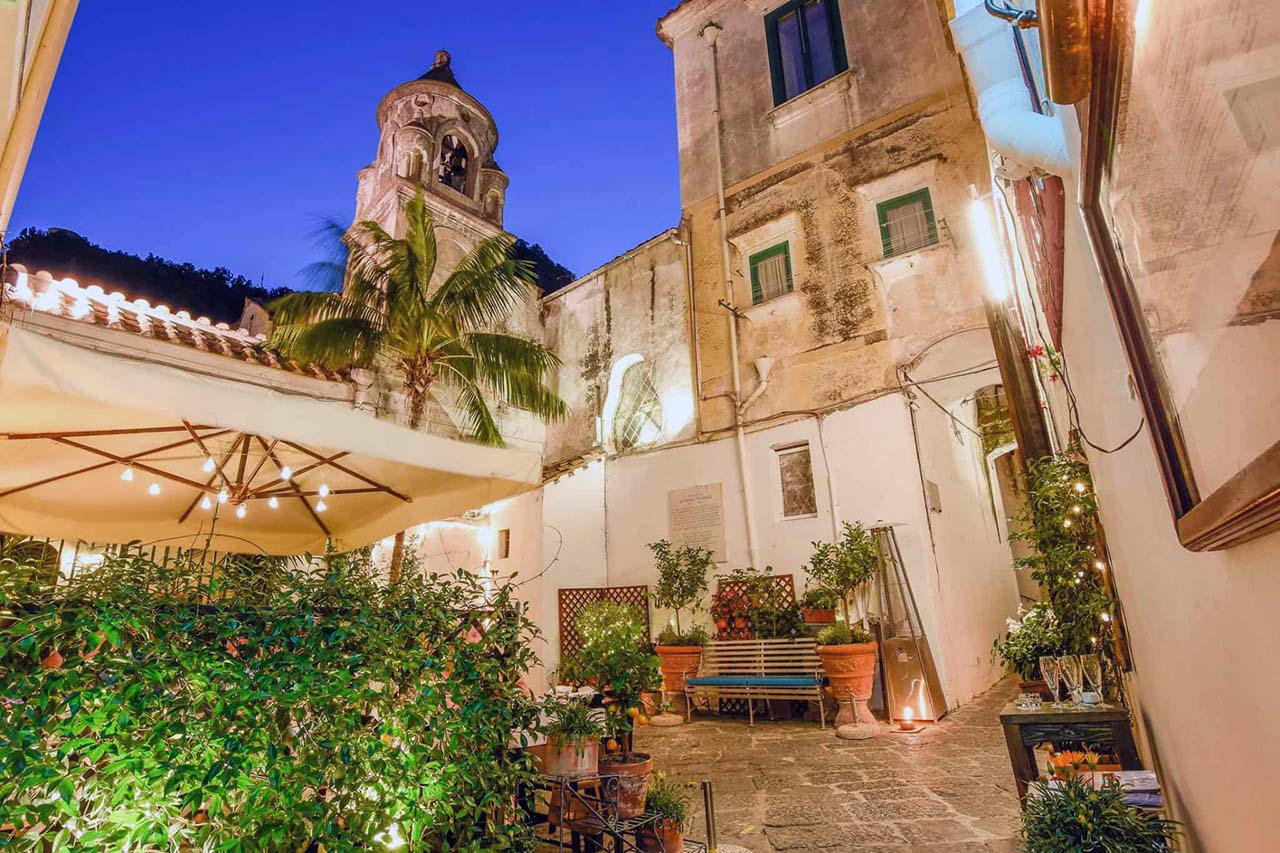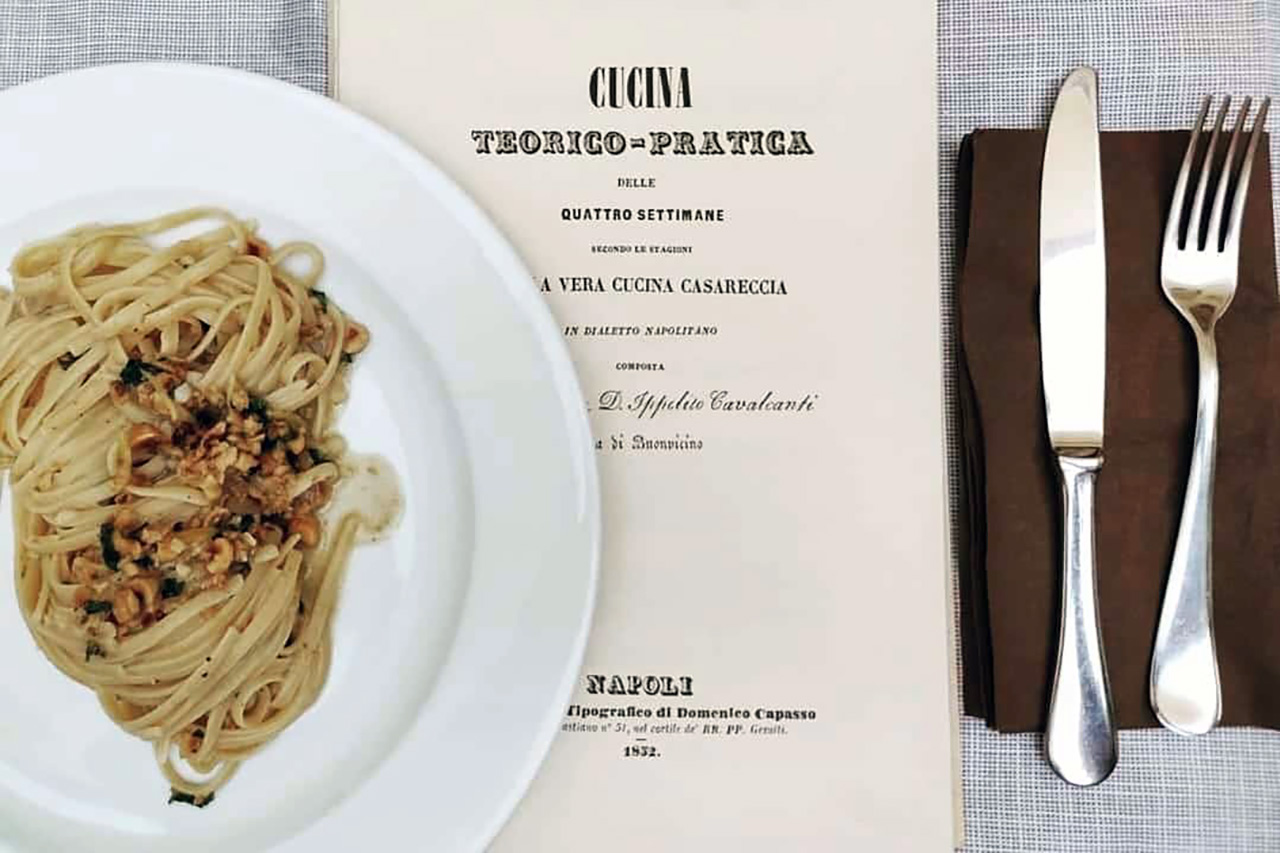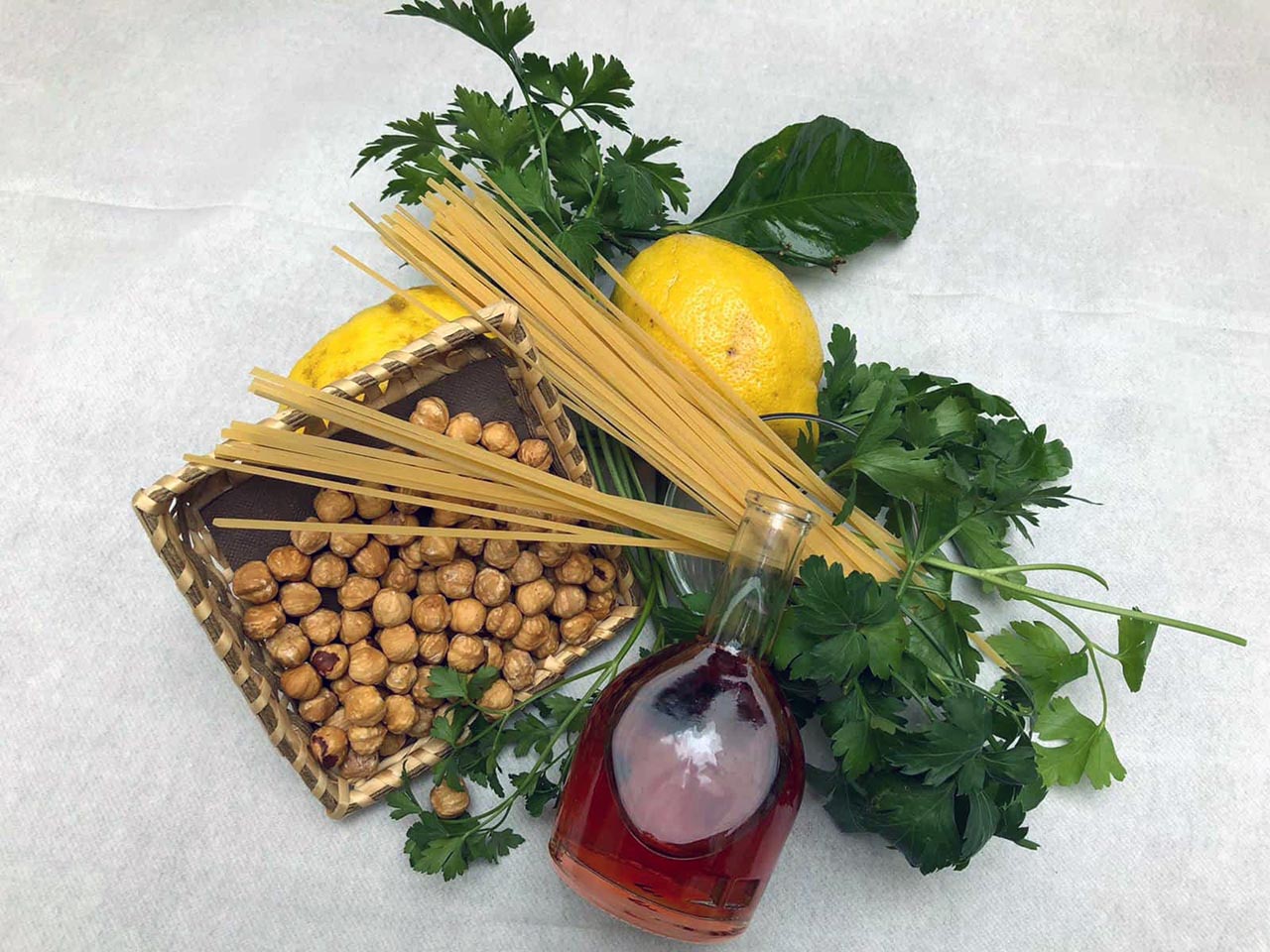In Amalfi, a slice of moonlight, a steaming soup, and a glass of wine are among romantic and timeless atmospheres.
January 28th, 2022.By Annamaria Parlato
Looking at the alleys of the enchanting Amalfi, intricate and charming bottlenecks, the story of Taverna Buonvicino began about eight years ago, thanks to the entrepreneurial intuition of Nicola Scocca, Gaetano Buonocore, and Antonio Gambardella, restaurateurs by vocation.
“We started as a game since we work every day doing different jobs, as a sign of friendship that binds us in love with these intricate alleys and the beauty they emanate,” they say. So let’s discover what is hidden in the Casbah of Amalfi.

The alleys: a puzzle of moments, a sponge soaked with sensations
“Scalinatèlla, longa longa longa longa… Strettulélla strettulélla… Scalinatèlla saglie ‘ncielo o scinne a mare…” this is how the song of 1948 by the great composers Cioffi and Bonagura recited. It is in the alleys that one must get lost. Here is the pulsating soul of a place and its inhabitants: whoever arrives on the Amalfi Coast is fascinated by it.
In the first half of the twentieth century, the Mediterranean architecture includes the archetypes of the constructive tradition of the Spanish coasts, central-southern Italy, and Greek-Arabic architecture. It is precisely a tangle of alleys, streets that end in gardens of lemons, high walls that hide the vegetable gardens, large wooden doors, ancient stone portals, pickets in the shape of a hand, man, animal, courtyards paved with tiles, wells where ivy grows, high terraces with the inevitable row of geranium plants and woven iron grates of the cellars.
The architectural landscape of the Amalfi Coast, typically Mediterranean, has been transformed by Saracen incursions and natural dangers, such as floods and seaquakes. For this reason, with the passing of the centuries, the dwellings have perched further inland, rising in altitude. Today’s result is an urban center developed in height, with narrow streets and alleys between the white houses.
A privileged position for a dream location between votive shrines and Saracen architecture
The alleys are full of charm and mystery. You have to walk them without haste paying attention to the beauty of buildings, monuments, squares, and churches you meet along the way. There are very characteristic votive aedicules, temples, and majolica tiles built to affirm religious devotion and to claim ownership of buildings and gardens along the way.
Amalfi hides many beauties among its paths. The Taverna Buonvicino is located right in the heart of them. In the corner of S. Maria Maggiore, you can visit the homonymous church with its beautiful Moorish bell tower, restored in 1607, founded by Duke Mansone III in 986 AD, and consecrated in 1161. It was profoundly remodeled in the Baroque period. It was initially built with three naves with apses divided by columns. It preserves inside many paintings the remains of S. Felice and a valuable crib of the eighteenth century.
Adjacent is the Church of S. Maria Addolorata, founded at the end of the XVIII century. It preserves numerous six-eighteenth-century paintings, a sixteenth-century marble statue representing the Madonna and Child, a late Gothic bas-relief depicting the Crucifixion, and a Renaissance Pietà. The church is the seat of the homonymous Archconfraternity founded in 1777.
The Brothers organize the Vespers of the Holy Week and the suggestive Procession of the Battenti, the white-hooded men who carry the “Mysteries,” symbols of the Passion and death of Christ in procession. If you go on to the Salita Bonelli, you arrive through the suggestive alleys in the ancient Rione San Simone. Amalfi reserves many secrets to discover.

Duke Ippolito Cavalcanti da Buonvicino, the gastronome who revolutionized Neapolitan cuisine
The restaurant and pizzeria are a tribute to the charismatic figure of Duke Ippolito Cavalcanti da Buonvicino. Born in Afragola in 1787 to a noble family of barons from the feud of Buonvicino in Calabria, he was a descendant of Guido Cavalcanti, a friend of Dante and poet of the “Dolce Stil Novo.” He owned in Naples a magnificent noble palace in Via Toledo. Besides the famous gastronomic treatise, titled “La Cucina Teorico Pratica” (Theoretical and Practical Cooking) of 1837 in its first edition, he also wrote two little books of a religious character, which wanted to dictate precise rules about sacred rites. La Cucina Teorico Pratica (Theoretical-Practical Cooking) had many editions, about ten, which witnessed its colossal fortune. The Duke subdivided the manual into two parts, something unusual for that time. The first section was written in Italian for nobles and the wealthy bourgeoisie, and the second was written in Neapolitan dialect for the familiar people and the bourgeoisie. Ippolito also added in the Neapolitan dialect some dishes for the important occasions of the year (second edition of 1839, with the appendix Cusina casarinola co la lengua napolitana).
The recipes he proposed were full of “French-style” ingredients since it was fashionable to cook beyond the Alps. Still, the Duke was also one of the lower classes’ forerunners of typical Neapolitan dishes later used. In 1839 there was also a version of Neapolitan ragout and, above all, the most ancient recipe of spaghetti with tomato sauce and the traditional sartù rice. The Duke died in 1859, leaving to posterity a significant burden, that of the beautiful art of cooking traditional Neapolitan dishes.
Enza Scocca, chef of the Taverna, lover of reasonable, fair, and clean food
Enza Scocca coordinates the kitchen of the restaurant-pizzeria, Nicola’s sister, who, however, avails herself of the collaboration and expertise of Antonella Porpora. The elegant and suggestive restaurant is embellished with contemporary paintings and ceramics. The mise en place, with its warm tones, makes the time spent at the Taverna pleasant.
The wine cellar keeps precious bottles of national and international wines, but the cuisine surprises and ravishes. “I demand a lot from what I cook, – says Enza – My dishes must combine the pleasure of taste with that of health. I want to exploit natural resources and return the energy taken away, to be viable to reward the efforts of those who produce it. I entrust it with many impossible missions, but if the raw materials are chosen consistently, all those missions will be accomplished.”

Dishes from Taverna Buonvicino
The escarole stuffed with cod mantecato with papaccelle, capers, and olives, the linguine with colatura di Alici di Cetara DOP, Giffoni IGP hazelnuts, and zest of Sfusato Amalfitano, the chestnut fish or the baked ombrina, the Genovese with Montoro copper onions and its meat with a side dish of hand-cut Praianesi fried potatoes, grouper all’acqua pazza, anchovies au gratin, farmer’s caponata, cannolicchi and fava beans soup, stuffed sardines with fried golden lampascioni, walnuts, and caramel tart, are dishes born from the chef’s skill and knowledge of the past combined with modern culinary techniques. These dynamics come together perfectly and harmonically without any perplexity or uncertainty during the tasting.
DOC pizzas with “Denomination of Neapolitan Origin
With a long leavening process, the pizza was renamed DON (Denomination of Neapolitan Origin) and entered in the summer of 2020. The pizzaiolo Ferdinando Criscuolo, coordinating with the chef, was also able to bring the kitchen dishes on the pizzas that have conquered the customers.
Nando, with satisfaction, explained his idea of a territorial pizza: “I thought of creating the Buonvicino pizza with hazelnuts, colatura, and lemon zest since Linguine alla Buonvicino is our signature dish, as well as Mandorlata with fiordilatte, friarielli garlic and oil, salted anchovies and toasted almonds. Monaco was another trendy pizza in the winter with fiordilatte, red pumpkin, provolone del Monaco cheese flakes, and a frame filled with ricotta cheese and salami”.
